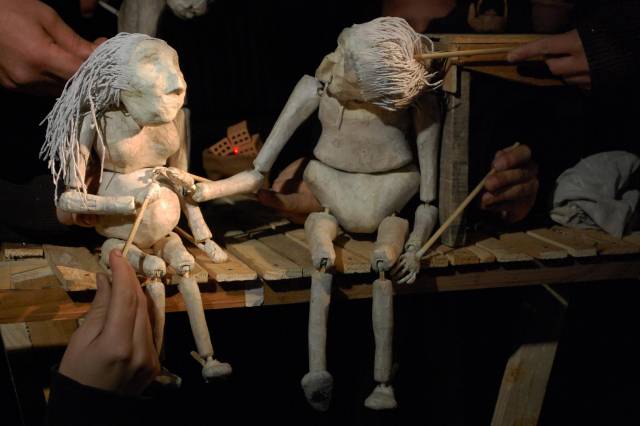

HERE’s Dream Music Puppetry Program in New York City presents the debut tour of Chilean company Silencio Blanco, who are bringing their show Chiflón, el silencio del carbón to American audiences. The company is known for their exquisitely simple puppetry work, and for the way in which they touch upon social issues through their work. Their gorgeous paper puppets are used to tell stories of survival, human courage and strength, such is the story they tell in Chiflón, el silencio del carbón which touches on the inhuman conditions of working in a coal mine. The artists at Silencio Blanco answered to some questions we had about their aesthetics, intentions and why they wanted to bring this show to America.
How do you select the stories you want to tell?
We seek to find a transversality between poetics and aesthetics. We want to speak about silence, through silence. We don’t really look for stories, but for the beauty of daily life. This is why we’ve focused on simple characters who usually work in fields that have disappeared as the world becomes more developed. These are usually silent jobs that also have been silenced (by history, by politics, by us). We’re interested in the inner lives of simple people, we want to highlight what makes us similar, we want to show their beauty, heroism, their suffering, their silence. All those things that live next to us, we don’t have to go anywhere to find them.
How do you come up with the look of each show?
The characters we choose define the look through their world, surroundings, color, temperature. Their job defines their postures, bodies and the specific aesthetics. We build the puppets using newspaper and wood from fruit crates. We believe the more simple the puppets are, the closer the audience can get to them.
What visual references did you use specifically for Chiflón, el silencio del carbón?
All of the references for Silencio Blanco’s puppets come from the search for simplicity, and reject everything that didn’t really complete them. The puppets should be white, like a blank page for the audience, in that way making them part of the illusion, allowing them to become creators. We want audience members to tell us their own story, that’s why our puppets have no mouths, eyes, or faces. Audience members help complete the act of communication according to their own life experiences. For the puppets in Chiflón, el silencio del carbón, we travelled to Lota, a mining town in the south of Chile, it was the place where the best coal came from. We wanted to see the Devil’s Wind Mine, but above all we wanted to see the people who were part of its history. We shared with former miners and with people who live in a now abandoned world of mining, these people gave us what we needed to create the puppets. That’s why none of the puppets in this show have a very specific look, the woman represents all women we met, the woman who waits, who sustains...the miner represents old and young men alike.
In Baldomero Lilo’s story the mine becomes a monster that swallows people whole. As Chilean artists can you talk about the dichotomy that exists between how exploiting mines is necessary to live, but also how the mine owners exploit the workers?
Of course, and not just as Chileans, this is universal. It happens everywhere which is why the show has been so successful abroad.
Puppetry allows audience members to become part of the artifice. Why is it important to make audiences aware of their own power to create?
We give them a voice, and we give them creation. We want to share with the audience, the stage and the seats are different spaces but we are all united by our emotions. Communication is only complete when it has two parts, art can’t only be what the artist wishes to express, it needs the audience to make it a full experience. Audience members are who decide to complete the cycle and complete the magic of the artifice, they choose to believe, trust and give themselves to it.
Your shows are kid friendly and nowadays kids shows are very busy and overstimulate them, how do you approach the younger audiences?
People need creative work, everything nowadays is handed out in its complete form, ready to be consumed, everything from art to food. The receiver never needs to work, so they don’t create. If we don’t create, we disappear, we let the power of others dictate who we are. We approach children the same way we approach everyone else, from a place of simplicity, showing them the beauty of the quotidian.
What’s the most exciting part of touring the US?
This is a very “strange” time in the US, and here we come from the Third World to show something so simple to people in the most powerful country, the place from where we receive the most information. It’s nice to change a country’s perception through people’s perception. We get excited just to be near the people, we’re excited something so simple and human is bringing us to the US.
For tickets to Chiflón, el silencio del carbón click here.